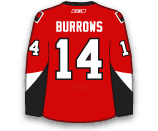Vey served as a healthy scratch in Wednesday’s win over the Oilers, but will be back in tonight vs. the Ducks. Vey has recorded four goals and five assists in 18 games this season.

Vey served as a healthy scratch in Wednesday’s win over the Oilers, but will be back in tonight vs. the Ducks. Vey has recorded four goals and five assists in 18 games this season.

Ouellet was recalled on Wednesday after the Red Wings placed Brendan Smith on IR. Ouellet will be paired with Brian Lashoff tonight, in what will be his season debut. He has no points in four career NHL games, but had five points (1G / 4A) in 13 games with GR before his recall.

Jokipakka will slide back into the Stars lineup tonight for the first time since November 1st. Jokipakka will look to have a strong game in order to carve out a long-term role on the Stars’ blue line in a state of flux right now. He has no points and a minus-3 rating in three games.

Paajarvi will be back in the lineup tonight after sitting for the last three games. He has one assist in six games this season and is expected to skate with Alex Steen and Paul Stastny tonight vs. the Habs.

Drouin hasn't gotten off to as hot a start as planned with 1 goal and 7 assists in 12 games.

Brunner has 4 points in 12 games this season

Briere has served as a healthy scratch for the last seven games, so they will get him back into the lineup tomorrow vs. the Rangers. He will replace Dennis Everberg and is expected to skate in the bottom-6

Hertl picked up one assist with a plus-1 rating and three shots in the Sharks’ 4-1 loss to the Panthers last night. He was moved up to the first line prior to yesterday’s game, but only played 13:38 which means he was likely bumped down midway through the contest. He is back on the third line this morning, so expect him to stay there to start Thursday’s game in Tampa Bay.

Volchenkov was suspended for his hit on Flames rookie Michael Ferland on October 31st. Ferland suffered a concussion on the play and still is not back. He will be paired with Seth Jones tonight.

Matthew Nieto has not scored since opening night and has been held pointless in his last three games so Tomas Hertl will replace him on the top line tonight vs. the Panthers. After a sensational rookie season prior to his knee injury, Hertl’s seven points (3G / 4A) has too be disappointing for fantasy investors. But, he gets a chance tonight to make an impact and hopefully stay on that top line.

Moore was suspended on October 27th for a hit on Erik Haula. He returns to the lineup tonight and will be paired with Mike Kostka. Moore has recorded just one assist in nine games so far this season.

After spending last week on the Hurricanes’ third-line, Skinner is skating with Eric Staal and Alex Semin at the game day skate. Skinner has picked up a goal and assist in his last two games and should be able to keep it going tonight on the top-line.

Ference was suspended for three games for his hit on Zack Kassian on November 1st. Ference will be paired with Justin Schultz, which means that Martin Marincin will come out of the lineup.

The Flyers tried Chris VandeVelde on the top line on Thursday, but will have Simmonds there to start the game tonight. Simmonds is a natural RW who will shift to the left side, but playing with Jakub Voracek and Claude Giroux should provide ample scoring chances for the big winger. Simmonds has cooled off after a hot start, but has six goals and three assists with a plus-10 rating in 13 games this season.

Bourque was scratched on Wednesday vs. the Sabres and will sit out for a second straight game. He has just two assists and a minus-9 rating in 13 games this season. Travis Moen will be in the lineup with Bourque scratched and Michael Bournival out with a shoulder injury.

Kuznetsov had recently been bumped up to the second line and it looked like all was going well, but he will sit tonight with Brooks Laich returning to the lineup. He has one goal and five assists in 12 games this season.

Horvat had a solid NHL debut on Tuesday, recording a plus-1 rating with one shot and one blocked shot in 8:52 of ice time. With Alex Burrows returning to the lineup tonight, Horvat will be the one who sits.

Burrows was suspended for his hit on Alexei Emelin on October 30th, he had to sit the last three games but will be back in the lineup tonight in San Jose. He has two goals and four assists in 10 games. Along with Nick Bonino and Chris Higgins, the Canucks second line has been providing a lot of secondary scoring to start the year.

Jurco has just two assists in the first 12 games of the season for the Red Wings. He has averaged 12 minutes a game but will be replaced but Andrej Nestrasil tonight in New York.

Nestrasil served as a healthy scratch in the Red Wings two losses on Sunday and Tuesday. He had recorded one assists and a minus-1 rating in 10 games this season. He will replace Tomas Jurco in the lineup tonight.
